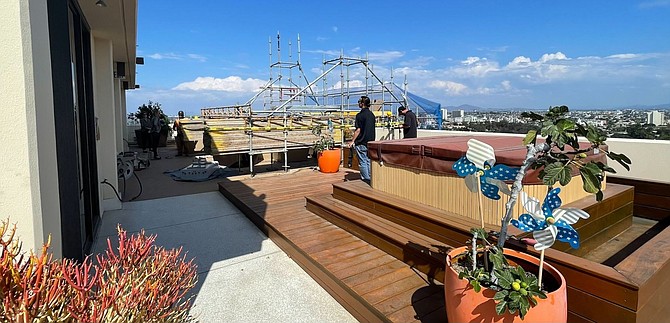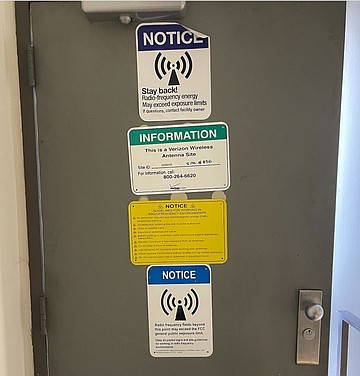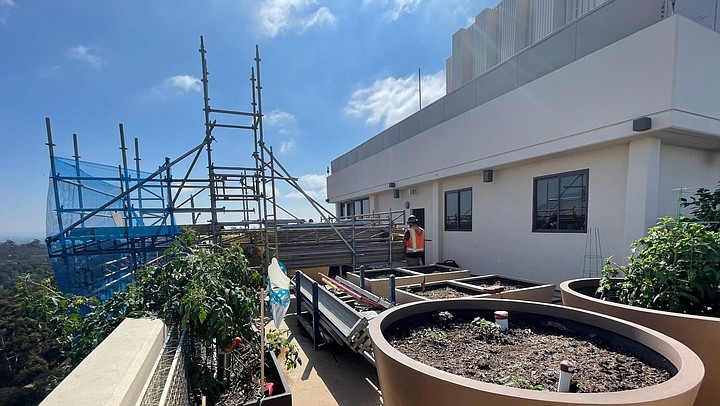 Facebook
Facebook
 X
X
 Instagram
Instagram
 TikTok
TikTok
 Youtube
Youtube

A rooftop battle over radio-frequency (RF) emissions has been won by telecom giant Verizon - for now. It's not over, say attorneys for Carole Sachs, who owns and lives in the uptown penthouse condo that sits 20 feet below a growing field of antennas.
"The only mitigation Verizon has offered are hot zone signs, to be posted all along her outdoor space," said Judd Gray, representing Sachs in her appeal to the city.

The project, called Verizon San Diego Zoo, is meant to improve wireless services for the community. It was approved by the Planning Commission on December 15, 2022, and the Uptown Community Planning Group voted in favor.
Sachs may be the only one not benefiting. Her 4,427-square-foot unit and its terrace is the entire upper floor of 666 Upas Street, just off Sixth Avenue. Her lost appeal of the project shows how little say residents of high rise buildings have when wireless companies decide the elevated site is the perfect place to put antennas.
"She's homebound, she can't escape," Gray said of the elderly Sachs, who is in her 80s and suffers dementia.
According to the appeal, the homeowner association has been approving upgrades and agreements with cellular providers for the last 20 years, adding ever more high-frequency transmitters next to her condo.
"Very disconcertingly, in 2017 and then again 2019, a metal plaque was installed on Ms. Sachs’ balcony, warning her to 'Stay back!' because 'radio-frequency energy may exceed exposure limits.'”
At about the same time, her employees, who spent hours gardening and sitting on the terrace, began complaining of headaches and other symptoms they attributed to the cellular emissions.
An environmental testing firm hired by Sachs found that between 2017 and 2020, the power density levels had shot up anywhere from 476 to 3,933 percent. Certain spots on the east side of the terrace exceeded most international and regulatory threshold limits.

And it was about to get worse.
Last August, she was given notice that the HOA had sought a conditional use permit to install more antennas above or around her home. She was told there were two active projects involving cell phone antennas: a Sprint/T-Mobile upgrade and Verizon San Diego Zoo.
The most recent survey from the testing firm she hired reports that "total cellular RF levels on average significantly increased since our previous survey conducted on October 11, 2022."
And the measurements only reflected the current antennas and traffic during the visit. "It is likely that with increased smart phone use and additional antenna configurations, the RF levels may increase."
Indoors, the highest radio frequency levels were in the living room, which they attributed to antennas on the building. The levels in other indoor areas were far lower, "due to the location and directionality of the antennas and attenuating effect of building materials."
Kevin Sullivan with Verizon suggested T-Mobile, which has been operating there for 20 years, is the bigger problem. Some of their equipment is closer to the condo, he said. The appeal focused "exclusively on Verizon, not T-Mobile...but it appears it should be T-Mobile."
All of Verizon's work will be on the roof, access will be through the interior, and there will be no construction on her property, he said. He asked the council to approve Verizon's "relatively minor update."
Despite what Sachs's attorneys said was a "remarkable increase in cellular emissions on her terrace" shown in the latest survey - they still fall just within FCC guidelines in most areas - crippling any effort to oppose the upgrade on health and safety grounds.
The guidelines haven't been updated since 1996. They're also significantly higher than many other countries allow, the appeal noted. And they don't consider potential “non-thermal” impacts, such as cancer, neurological impacts, and immune system deficiencies.
Up on the roof, and in areas around Sachs's terrace, emissions will exceed FCC limits, but according to Verizon, with mitigation measures they will still be compliant.
Sullivan said the measures will be signs posted at access doors and barriers placed around the antennas, "to provide full clarity of where you should and shouldn't go."
Anyone working on the roof, he said, "must be aware these are hot zones. They must have proper training, information from the owner about RF - in this instance, the HOA."
Councilman Joe LaCava, who seconded Whitburn's motion to deny the appeal, said the unresolved issues of unwanted radio-frequency near homes didn't make him happy, but it's not a topic local governments can debate.
"This council body - their hands are tied."
One thing the city can do, he urged, is put naming rules in place, as they discussed 15 years ago - so projects like this one can't be named after the zoo. "It can have an undue influence."


A rooftop battle over radio-frequency (RF) emissions has been won by telecom giant Verizon - for now. It's not over, say attorneys for Carole Sachs, who owns and lives in the uptown penthouse condo that sits 20 feet below a growing field of antennas.
"The only mitigation Verizon has offered are hot zone signs, to be posted all along her outdoor space," said Judd Gray, representing Sachs in her appeal to the city.

The project, called Verizon San Diego Zoo, is meant to improve wireless services for the community. It was approved by the Planning Commission on December 15, 2022, and the Uptown Community Planning Group voted in favor.
Sachs may be the only one not benefiting. Her 4,427-square-foot unit and its terrace is the entire upper floor of 666 Upas Street, just off Sixth Avenue. Her lost appeal of the project shows how little say residents of high rise buildings have when wireless companies decide the elevated site is the perfect place to put antennas.
"She's homebound, she can't escape," Gray said of the elderly Sachs, who is in her 80s and suffers dementia.
According to the appeal, the homeowner association has been approving upgrades and agreements with cellular providers for the last 20 years, adding ever more high-frequency transmitters next to her condo.
"Very disconcertingly, in 2017 and then again 2019, a metal plaque was installed on Ms. Sachs’ balcony, warning her to 'Stay back!' because 'radio-frequency energy may exceed exposure limits.'”
At about the same time, her employees, who spent hours gardening and sitting on the terrace, began complaining of headaches and other symptoms they attributed to the cellular emissions.
An environmental testing firm hired by Sachs found that between 2017 and 2020, the power density levels had shot up anywhere from 476 to 3,933 percent. Certain spots on the east side of the terrace exceeded most international and regulatory threshold limits.

And it was about to get worse.
Last August, she was given notice that the HOA had sought a conditional use permit to install more antennas above or around her home. She was told there were two active projects involving cell phone antennas: a Sprint/T-Mobile upgrade and Verizon San Diego Zoo.
The most recent survey from the testing firm she hired reports that "total cellular RF levels on average significantly increased since our previous survey conducted on October 11, 2022."
And the measurements only reflected the current antennas and traffic during the visit. "It is likely that with increased smart phone use and additional antenna configurations, the RF levels may increase."
Indoors, the highest radio frequency levels were in the living room, which they attributed to antennas on the building. The levels in other indoor areas were far lower, "due to the location and directionality of the antennas and attenuating effect of building materials."
Kevin Sullivan with Verizon suggested T-Mobile, which has been operating there for 20 years, is the bigger problem. Some of their equipment is closer to the condo, he said. The appeal focused "exclusively on Verizon, not T-Mobile...but it appears it should be T-Mobile."
All of Verizon's work will be on the roof, access will be through the interior, and there will be no construction on her property, he said. He asked the council to approve Verizon's "relatively minor update."
Despite what Sachs's attorneys said was a "remarkable increase in cellular emissions on her terrace" shown in the latest survey - they still fall just within FCC guidelines in most areas - crippling any effort to oppose the upgrade on health and safety grounds.
The guidelines haven't been updated since 1996. They're also significantly higher than many other countries allow, the appeal noted. And they don't consider potential “non-thermal” impacts, such as cancer, neurological impacts, and immune system deficiencies.
Up on the roof, and in areas around Sachs's terrace, emissions will exceed FCC limits, but according to Verizon, with mitigation measures they will still be compliant.
Sullivan said the measures will be signs posted at access doors and barriers placed around the antennas, "to provide full clarity of where you should and shouldn't go."
Anyone working on the roof, he said, "must be aware these are hot zones. They must have proper training, information from the owner about RF - in this instance, the HOA."
Councilman Joe LaCava, who seconded Whitburn's motion to deny the appeal, said the unresolved issues of unwanted radio-frequency near homes didn't make him happy, but it's not a topic local governments can debate.
"This council body - their hands are tied."
One thing the city can do, he urged, is put naming rules in place, as they discussed 15 years ago - so projects like this one can't be named after the zoo. "It can have an undue influence."
Comments